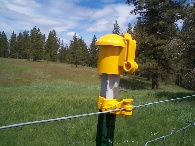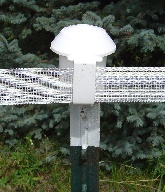Electric wire
This usually consists of one, two or three strands of 14 gauge wire.
We call this non-electric because currently one has to be a licensed electrician in order to install a electric fence, so we cannot at this time hook up a electric charger or install an electric fence, but we can install a non electric fence.
Ideal for adding extra security to existing systems for changeable confinement operations. Galvanized for resistance to rust and corrosion. Available in handy dispensing spools. Comes in 14 gauge 1/4 mile and 1/2 mile and 17 gauge 1/4 mile and 1/2 mile, found at your local farm hardware store.
Green or red T-posts
Are driven into the ground are spaced approximately 15 to 25 feet apart for Non electric.
We use 2 3/8 inch galvanized tube for end or corner supports with a concrete thrust block buried in the ground.
Gate posts are generally 2 7/8 inch or 4 inch for drive gates and 6 5/8 for large 14 ft. or over drive gates.

T-post with non electric wire and connector and cap for future non electric wire.
Electric wire
Electric wire became available in the 1950s and has been widely used for temporary fences and as a means to improve the security of fences made of other materials. It is made using lightweight steel wire (usually 14-17 gauge) attached to posts with insulators made of porcelain or plastic.
A fence charger places an electrical pulse from ground to the wire about once per second. The pulse is narrow and usually around 5-20 kV. Animals receive a painful but harmless shock when contacting the wire, and learn to stay away from it.
T-post caps are also an option, they come in black, white or yellow. There is a snap on the side of this connector to run a wire through if needed.
Ribbon fencing only lasts a couple of years until the ribbon starts to decay.

T-post with White Non electric ribbon and white cap.
High tensile (H-T or HT) fencing
Uses smooth, heavy gauge (usually 12.5 gauge, 2.5mm) steel wire was introduced in the 1980s and has slowly gained acceptance. It permits the use of wider post spacings and offers improved stock safety compared to barbed and woven wire fences. It can be insulated and electrified.
Most high tensile wire is sold as a coil, not on a spool. If you do not use some sort of turntable to dispense the wire, the risk of tangles and personal injury, especially to the eyes, is greatly increased. Set up the jenny loaded with wire on the ground.
You can walk away pulling the end of the wire and the jenny will spin, preventing your wire from tangling.

Spinning jenning
Class 3 coatings have over 250 percent heavier coatings of zinc than Class 1. This heavier coating will extend the time it takes for initial rust to appear by two to three times (six to thirty years versus two to eleven years).
Some confusion occurs when comparing different types or classes of galvanized coatings. Class 1 coatings, normally found on 12 gauge barbed wire and common smooth or woven wire field fencing, has the lightest zinc coating and thus the shortest life expectancy.
|

